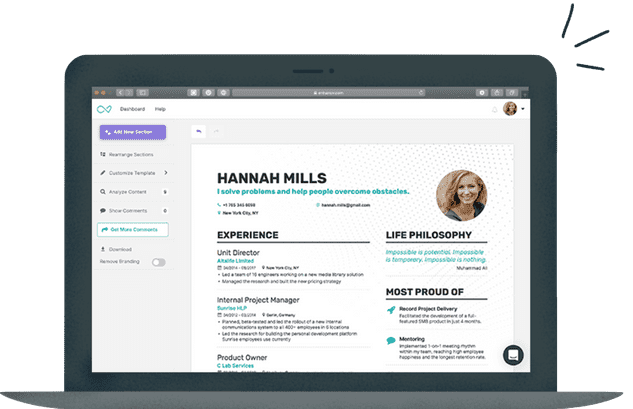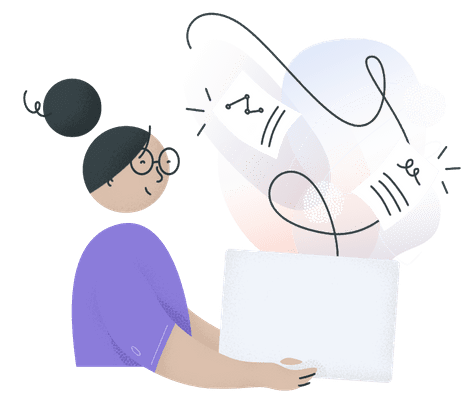Resume Skill Examples: The Right Mix of Hard Skills & Soft Skills
Hard skills are very specific abilities for each job or industry. You gain them through learning in school and in extracurricular classes, or through your job experience.
Soft skills, on the other hand, are different for each person. This is why recruiters consider them invaluable once they understand you demonstrate them on a regular basis. Soft skills can be used across every job industry, and often help in doing your job better.
Candidates with the right combo of hard and soft skills create a match between what they offer in terms of abilities, and what the company’s needs are. This is called a value proposition.
According to a 2018 job outlook report by National Association of Colleges and Employers, companies seek the following skills on applicants’ resumes:
Here’s a List of Top 20 In-Demand Resume Skills:
- Problem-solving
- Teamwork
- Written communication skills
- Leadership
- Work ethic
- Analytical skills
- Verbal communication skills
- Initiative
- Detail-oriented skills
- Adaptability
- Technical skills
- Interpersonal skills
- Computer skills
- Organizational skills
- Strategic planning
- Creativity
- Friendly personality
- Tactfulness
- Risk-taking
- Language fluency
Source: Job Outlook 2018 by NACE
How to List Skills on Your Resume
Study the company and match the job description
Before you list every single skill you’ve got, hear this - do you want to send your potential employer any irrelevant information? Instead, read the job description carefully, pinpoint the skills and abilities that match your own and back them with examples.
In addition, explore the company further through its website or social media profiles and learn more about its culture. You’ll be surprised to find other touchpoints you have between each other which weren’t obvious from the job description.
Let’s say, a job ad for a Mechanical Engineer may feature the following skills and experiences:
- Must be customer-focused, multi-tasker and detail-oriented
- Strong CAD skills with a focus on AutoCAD
- Experience in industrial design and knowledge of ACME is always a plus
- Must possess strong self-organisation skills
- Great verbal and written communication skills
- A minimum of Bachelor’s degree in Engineering/Industrial Design or equivalent
Therefore, you will have to include skills, like:
- Customer focus
- Multi-tasking
- Detail-oriented
- CAD
- Industrial Design
- Acme
- Organisation
- Communication
Use the STAR methodology to talk about your skills and experiences
STAR stands for situation - task - action - result and it’s a term recruiters use to describe your relevant experience by providing a context as to what specific actions you took and how they brought a beneficial result. Quantifying your achievements using numbers will make up for a stronger case in point.
Here’s an example:
- Situation: a devops engineer for a finance website
- Task: eliminate poor website performance during peak hours (stock opening hours)
- Activity: migrated the existing website’s database to a more optimal noSQL solution
- Result: reduced complaints rate to 3% and 100% website uptime during peak visit hours
Run every single line of your resume through the STAR method. Quantify your achievements whenever possible.
Select where in your resume to place your skills
Depending on your level of experience, you can place your skills in several sections of your resume.
Write a summary of qualifications
A resume summary is a short paragraph that delves into your top skills you gained throughout your career. They should be the most relevant for the job you are applying for. The resume summary sits on top of your resume, following the header section - that is, your name and contact data. A summary of qualifications is great when you’re switching careers or when you’ve got any employment gaps.
Create a separate skills section
With a separate skills section, you can highlight several important skills that can make them easily noticeable. We’ve seen examples of people using this section to highlight both their soft and hard skills.
Include your skills in your experience
The worst thing you can do for your resume experience section is to make a generic copy-paste of your previous job duties. Instead, write down how you’ve used specific skills to achieve goals using the STAR method mentioned above.
Map Your Skill Proficiency
You’ve probably seen fancy charts and level bars on resumes. They’ve become untrustworthy mainly because candidates apply an arbitrary assessment of their skills.
Instead, let’s introduce you to one the few widely accepted frameworks to evaluate your skill level - published by the National Institutes of Health.
Use that framework as a reference point when evaluating your skills. You’ll be able to show your right level of competency on your resume.
- Fundamental knowledge - you possess common knowledge on basic concepts and theories. You’re expected to still learn the ropes around the skill at hand.
- Beginner - your level of experience with a particular skill is at a school/university level or just after a traineeship period. You’re expected to receive help from more experienced people.
- Intermediate - you can operate with this skill almost independently, and will need an expert eye from time to time. You’ve applied the skill in practice with minimal guidance and interference from senior level colleagues.
- Advanced - you’re one of the few immediate choices for “a person to ask” about a problem or idea associated with that particular skill. You’ve applied your knowledge in practice multiple times and you can teach others how to use it, too.
- Expert - you’re widely recognised as one of the highest authority figures in this skill area both your own organisation, and outside of it, too. You’ve consistently demonstrated excellent application of that particular skill.
Get more inspiration
No spam, just information that will help you build a resume that makes you feel relevant and well represented.

